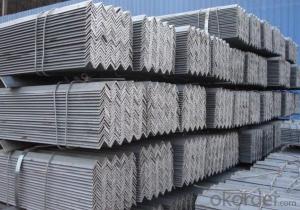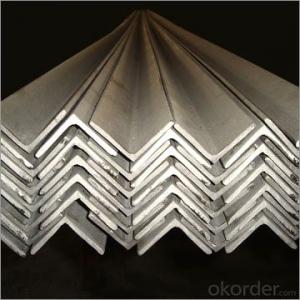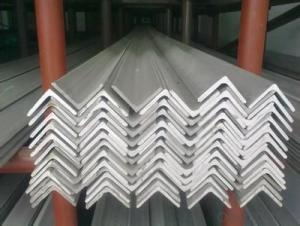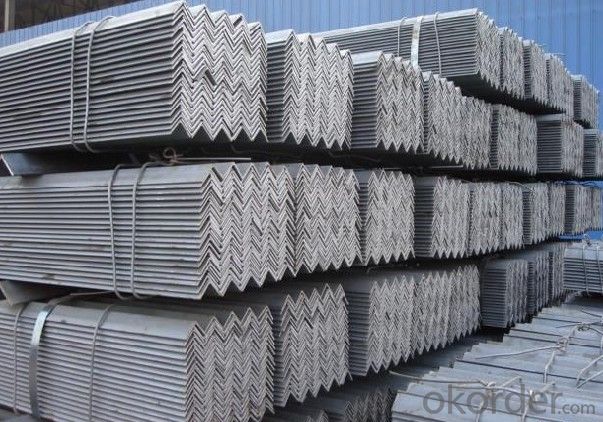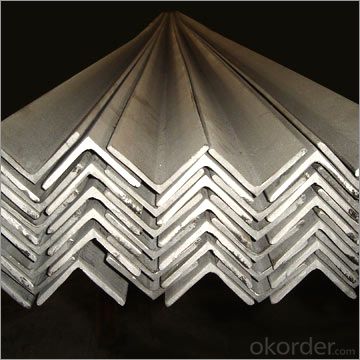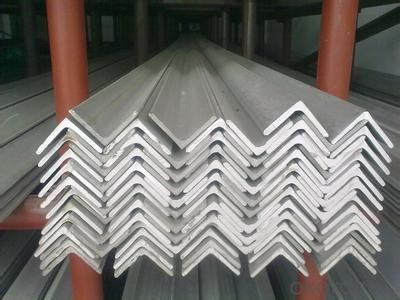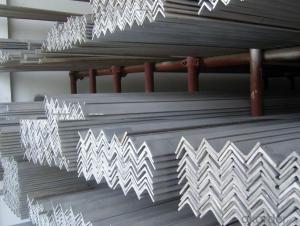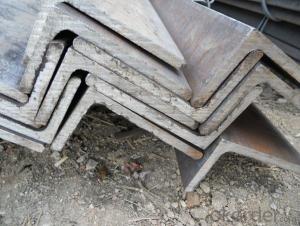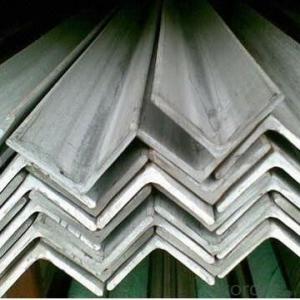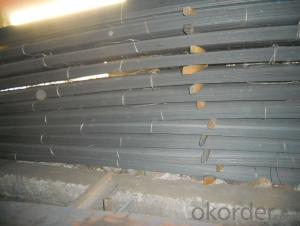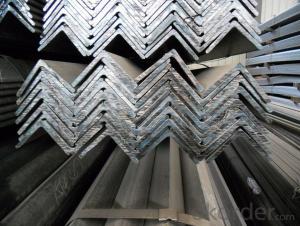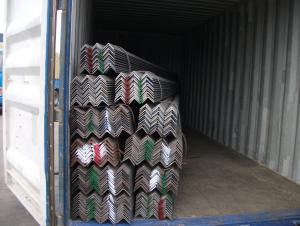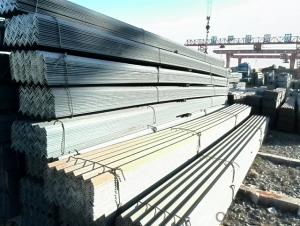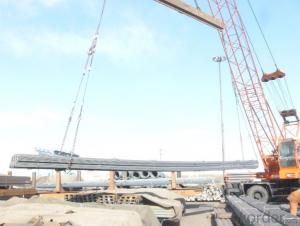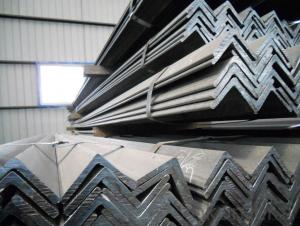Equal Angle Steel Hot Rolled High Qulaity
- Loading Port:
- Tianjin
- Payment Terms:
- TT OR LC
- Min Order Qty:
- 25 m.t.
- Supply Capability:
- 20000000 m.t./month
OKorder Service Pledge
OKorder Financial Service
You Might Also Like
Specification
Product Description:
OKorder is offering Equal Angle Steel Hot Rolled High Qulaity at great prices with worldwide shipping. Our supplier is a world-class manufacturer of steel, with our products utilized the world over. OKorder annually supplies products to European, North American and Asian markets. We provide quotations within 24 hours of receiving an inquiry and guarantee competitive prices.
Product Applications:
According to the needs of different structures, Angle can compose to different force support component, and also can be the connections between components. It is widely used in various building structures and engineering structures such as roof beams, bridges, transmission towers, hoisting machinery and transport machinery, ships, industrial furnaces, reaction tower, container frame and warehouse etc
Product Advantages:
OKorder's Steel Equal Angle Steel Hot Rolled High Qulaity are durable, strong, and resist corrosion.
Main Product Features:
· Premium quality
· Prompt delivery & seaworthy packing (30 days after receiving deposit)
· Corrosion resistance
· Can be recycled and reused
· Mill test certification
· Professional Service
· Competitive pricing
Product Specifications:
Manufacture: Hot rolled
Grade: Q195 – 235
Certificates: ISO, SGS, BV, CIQ
Length: 6m – 12m, as per customer request
Packaging: Export packing, nude packing, bundled
Sizes: 25mm-250mm | ||||||||||||
a*t | ||||||||||||
25*2.5-4.0 | 70*6.0-9.0 | 130*9.0-15 | ||||||||||
30*2.5-6.6 | 75*6.0-9.0 | 140*10-14 | ||||||||||
36*3.0-5.0 | 80*5.0-10 | 150*10-20 | ||||||||||
38*2.3-6.0 | 90*7.0-10 | 160*10-16 | ||||||||||
40*3.0-5.0 | 100*6.0-12 | 175*12-15 | ||||||||||
45*4.0-6.0 | 110*8.0-10 | 180*12-18 | ||||||||||
50*4.0-6.0 | 120*6.0-15 | 200*14-25 | ||||||||||
60*4.0-8.0 | 125*8.0-14 | 250*25 | ||||||||||
FAQ:
Q1: Why buy Materials & Equipment from OKorder.com?
A1: All products offered byOKorder.com are carefully selected from China's most reliable manufacturing enterprises. Through its ISO certifications, OKorder.com adheres to the highest standards and a commitment to supply chain safety and customer satisfaction.
Q2: How do we guarantee the quality of our products?
A2: We have established an advanced quality management system which conducts strict quality tests at every step, from raw materials to the final product. At the same time, we provide extensive follow-up service assurances as required.
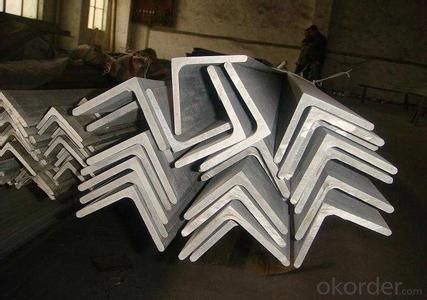
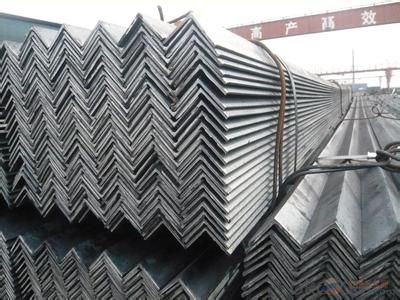
- Q: Can steel angles be used for reinforcing steel structures?
- Yes, steel angles can be used for reinforcing steel structures. Steel angles are versatile and widely used in construction projects for their strength and durability. They can be used as reinforcements to strengthen and provide additional support to steel structures such as beams, columns, and trusses. Steel angles are often used in conjunction with other reinforcing materials, such as steel bars or mesh, to enhance the overall structural integrity of the steel structure. The angle shape of the steel angles allows them to be easily welded or bolted into place, making them a popular choice for reinforcing steel structures. Additionally, steel angles come in various sizes and thicknesses, allowing for flexibility in design and application. Overall, steel angles are an effective and commonly used option for reinforcing steel structures.
- Q: Can steel angles be used for architectural purposes?
- Yes, steel angles can be used for architectural purposes. They are commonly used in the construction industry for various architectural applications such as support brackets, frames, and reinforcements. Steel angles provide structural stability and can be easily customized and integrated into architectural designs to meet specific requirements.
- Q: Are steel angles affected by creep?
- Steel angles can experience creep, which is when a material gradually deforms over time under a constant load or stress. Despite steel's strength and durability, it is not completely resistant to creep. The extent of creep in steel angles depends on factors like the type of steel, temperature, and applied load. Creep can occur in steel angles when exposed to high temperatures or when under sustained loads for extended periods. At high temperatures, the atoms in the steel move faster, causing gradual deformation. This is a concern in applications involving industrial furnaces or boilers, where steel angles are exposed to sustained high temperatures. Sustained loads can also lead to creep in steel angles. Over time, the constant stress on the material causes slow and progressive deformation. This is particularly significant in situations like long-span bridges or tall buildings that subject steel angles to heavy loads for extended periods. To address potential creep effects, engineers and designers must consider application requirements and select the appropriate type of steel angle and design parameters. They may also incorporate additional measures, like support or reinforcement, to minimize the impact of creep on structural integrity. Regular inspection and maintenance help identify signs of creep and take necessary measures to address them.
- Q: Can steel angles be used for storage racks?
- Yes, steel angles can be used for storage racks. Steel angles are commonly used in the construction industry for their strength and durability. They can easily be shaped into various configurations, including the design of storage racks. The angles provide structural support and stability, making them ideal for storing heavy items. Additionally, steel angles are resistant to corrosion, which is important for maintaining the integrity of the storage racks over time. Overall, steel angles are a reliable and commonly used material for constructing storage racks.
- Q: Can steel angles be used for stairs or handrails?
- Yes, steel angles can be used for stairs or handrails. Steel angles are commonly used in construction as they provide structural support and stability. When used for stairs, steel angles can be incorporated as stringers or supports, ensuring the stability and strength of the staircase. Similarly, for handrails, steel angles can be used as the main frame or support structure, providing a sturdy and safe handrail for users. The use of steel angles in stairs and handrails offers durability, resistance to wear and tear, and the ability to withstand heavy loads, making them a popular choice in construction projects.
- Q: What are the different types of steel angle connections?
- There are several different types of steel angle connections, including bolted connections, welded connections, and hybrid connections. Bolted connections involve using bolts and nuts to connect steel angles together. Welded connections involve melting the steel angles together using heat and a welding process. Hybrid connections combine elements of both bolted and welded connections, using a combination of bolts and welding to secure the steel angles together.
- Q: Are steel angles fire-resistant?
- Steel angles possess a certain degree of fire resistance. Steel, as a non-combustible substance, does not ignite or contribute to the combustion process. Its exceptional melting point, typically hovering at 1370°C (2500°F), ensures that it retains its structural integrity even when subjected to high temperatures. Nevertheless, it is crucial to recognize that the fire resistance of a structure or component reliant on steel angles hinges on various factors, such as the design, dimensions, and arrangement of said angles, as well as the implementation of fire protection measures. Fire-resistant coatings, fireproofing substances, or fire-resistant insulation can be employed to bolster the fire resistance of steel angles. These supplementary fire protection methods have the capacity to provide a certain level of insulation, impeding the transfer of heat to the steel and prolonging the time it takes for the steel to reach its critical temperature. This grants occupants more time to evacuate the premises and affords firefighters an extended period to manage the fire. In conclusion, steel angles inherently possess fire resistance due to the properties of steel. However, the implementation of appropriate fire protection measures can augment their fire resistance capabilities.
- Q: How do you prevent steel angles from twisting?
- There are several methods that can be employed to prevent steel angles from twisting: 1. Proper fabrication techniques: Ensure that the steel angles are fabricated accurately and precisely, with straight and square cuts. This will help maintain the structural integrity of the angles and prevent them from twisting. 2. Bracing and supports: Use appropriate bracing and supports during the installation process to provide stability to the steel angles. These can include temporary supports, diagonal bracing, or cross bracing, depending on the specific application. 3. Welding techniques: When joining steel angles together, use proper welding techniques to minimize distortion and twisting. This includes using the correct welding process, ensuring proper heat control, and employing suitable fixturing to hold the angles in place during the welding process. 4. Anchoring methods: Depending on the specific application, anchoring methods such as bolting, screwing, or welding the steel angles to other structural elements can help prevent twisting. These anchoring methods provide additional stability and prevent the angles from rotating or twisting under external forces. 5. Regular inspections and maintenance: Conduct regular inspections to identify any signs of twisting or distortion in the steel angles. If any issues are detected, take immediate corrective action to rectify the problem and prevent further twisting. Overall, a combination of accurate fabrication, proper bracing and supports, appropriate welding techniques, anchoring methods, and regular maintenance can effectively prevent steel angles from twisting and ensure their structural stability.
- Q: What is the cost of steel angles?
- The cost of steel angles can vary depending on various factors such as the type of steel, the length and thickness of the angle, and the supplier. Generally, the price of steel angles is determined by the current market rates for steel, which can fluctuate over time. It is advisable to contact different suppliers or check online platforms to get specific price quotes for the steel angles you require.
- Q: What is the process of cold bending steel angles?
- The process of cold bending steel angles involves manipulating the angles into a desired shape without the use of heat. This is done by applying force or pressure to the angles in a controlled manner. First, the steel angle is secured in a bending machine or fixture that can hold it securely in place during the bending process. The operator then determines the desired angle and bend radius, which determines the amount of force that needs to be applied. Next, the bending machine or fixture applies pressure to the steel angle, gradually bending it to the desired shape. The force is typically applied slowly and evenly to prevent any deformation or damage to the steel. During the bending process, it is important to monitor the angle and ensure that it is bending evenly and smoothly. The operator may need to make adjustments to the pressure or angle of the bending machine to achieve the desired shape. Once the steel angle has been bent to the desired angle, it is carefully removed from the bending machine or fixture. It is important to handle the bent angle with care to prevent any distortion or damage. Cold bending steel angles offers several advantages over hot bending, such as reduced risk of material distortion or weakening due to heat. It also allows for more precise and controlled bending, making it suitable for a wide range of applications where accuracy is crucial. Overall, the process of cold bending steel angles involves securely positioning the angle in a bending machine or fixture, applying gradual and controlled pressure to bend it to the desired shape, and carefully removing the bent angle for further use.
Send your message to us
Equal Angle Steel Hot Rolled High Qulaity
- Loading Port:
- Tianjin
- Payment Terms:
- TT OR LC
- Min Order Qty:
- 25 m.t.
- Supply Capability:
- 20000000 m.t./month
OKorder Service Pledge
OKorder Financial Service
Similar products
Hot products
Hot Searches
Related keywords
